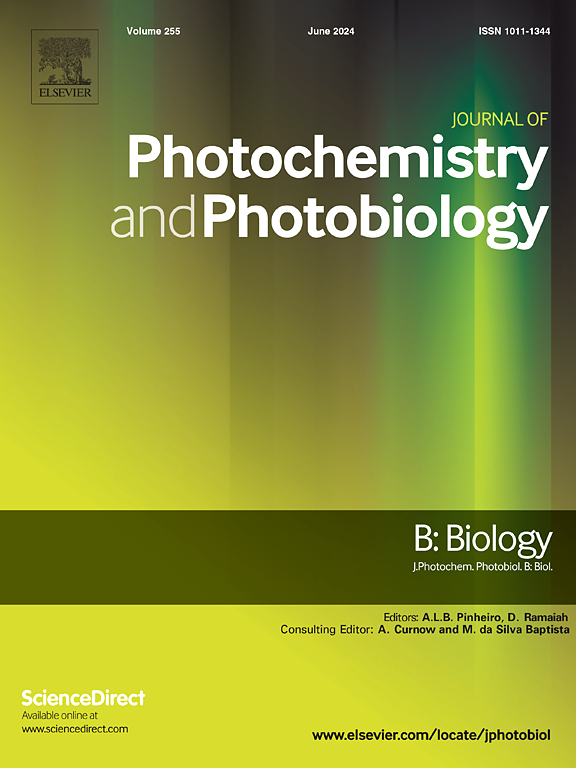The effect of 254 nm ultraviolet C promoting ethanol-induced gastric injury healing - A potential physical factor therapy
IF 3.7
2区 生物学
Q2 BIOCHEMISTRY & MOLECULAR BIOLOGY
Journal of photochemistry and photobiology. B, Biology
Pub Date : 2025-04-13
DOI:10.1016/j.jphotobiol.2025.113164
引用次数: 0
Abstract
Background
Gastritis, gastric ulcer, and gastric bleeding are associated with gastric mucosal injury. Chemical drugs are the current mainstream method, but the limitations are also increasingly apparent. Accumulative basic and clinical evidence has confirmed that ultraviolet C (UVC) has a significant effect on improving superficial infectious inflammation, promoting the healing of injured wounds, mucous membranes and ulcers, and killing microorganisms. It is possible to explore a new treatment method by introducing UVC light into the stomach to treat the damaged gastric mucosa.
Objective
This study evaluated the efficacy of introducing 254 nm UVC into the stomach by the self-made light guide at different doses and time to promote the healing of injured gastric mucosa, and explored the potential mechanism underling the treatment effect.
Methods
The rat model of gastric mucosal injury induced by ethanol was intervened by UVC with different radiation doses. The ulcer index, histopathology, CAT, SOD, MDA, NO, TNF-α, IL-6 and EGF in gastric mucosa and serum were evaluated. In addition, the expression of ASC, IL-1β and Caspase-1 in gastric tissue was evaluated.
Results
UVC significantly improved the histopathological condition of damaged gastric mucosa and reduce the ulcer index. UVC reduced the levels of TNF-α and IL-6, increase the level of EGF in serum. It also significantly increased the levels of SOD, CAT and NO, and reduced the levels of MDA in serum and gastric tissue. The expression of ASC, IL-1β and Caspase-1 in gastric mucosa was significantly inhibited, and it showed a significant dose-dependent trend with UVC irradiation dose.
Conclusion
Intragastric irradiation of 254 nm UVC can effectively promote the repair of damaged gastric mucosa by inhibiting inflammatory factors, activating antioxidant system and inhibiting the apoptosis-related proteins, which may provide a promising way for clinical application of physical factors in the treatment of gastric mucosal injury. However, whether the technology can be finally applied to clinical practice requires more rigorous safety and effectiveness studies.
254 nm紫外线C促进乙醇诱导胃损伤愈合的作用——一种潜在的物理因子疗法
背景胃炎、胃溃疡和胃出血与胃黏膜损伤有关。化学药物是目前的主流方法,但其局限性也日益明显。累积的基础和临床证据证实,紫外线 C(UVC)对改善浅表感染性炎症,促进损伤伤口、粘膜和溃疡的愈合,以及杀灭微生物有显著效果。本研究评估了通过自制光导管在不同剂量和时间下将 254 nm 紫外线引入胃内促进损伤胃黏膜愈合的疗效,并探讨了治疗效果的潜在机制。方法用不同辐射剂量的紫外线干预乙醇诱导的胃黏膜损伤大鼠模型。评价了大鼠溃疡指数、组织病理学、胃黏膜和血清中 CAT、SOD、MDA、NO、TNF-α、IL-6 和 EGF 的表达。结果 紫外线能明显改善受损胃黏膜的组织病理学状况,降低溃疡指数。紫外线降低了 TNF-α 和 IL-6 的水平,提高了血清中 EGF 的水平。它还能明显提高 SOD、CAT 和 NO 的水平,降低血清和胃组织中 MDA 的水平。结论254 nm 紫外线胃内照射可通过抑制炎症因子、激活抗氧化系统和抑制细胞凋亡相关蛋白,有效促进受损胃黏膜的修复,为物理因子在胃黏膜损伤治疗中的临床应用提供了一条可行的途径。然而,该技术能否最终应用于临床实践,还需要更严格的安全性和有效性研究。
本文章由计算机程序翻译,如有差异,请以英文原文为准。
求助全文
约1分钟内获得全文
求助全文
来源期刊
CiteScore
12.10
自引率
1.90%
发文量
161
审稿时长
37 days
期刊介绍:
The Journal of Photochemistry and Photobiology B: Biology provides a forum for the publication of papers relating to the various aspects of photobiology, as well as a means for communication in this multidisciplinary field.
The scope includes:
- Bioluminescence
- Chronobiology
- DNA repair
- Environmental photobiology
- Nanotechnology in photobiology
- Photocarcinogenesis
- Photochemistry of biomolecules
- Photodynamic therapy
- Photomedicine
- Photomorphogenesis
- Photomovement
- Photoreception
- Photosensitization
- Photosynthesis
- Phototechnology
- Spectroscopy of biological systems
- UV and visible radiation effects and vision.

 求助内容:
求助内容: 应助结果提醒方式:
应助结果提醒方式:


